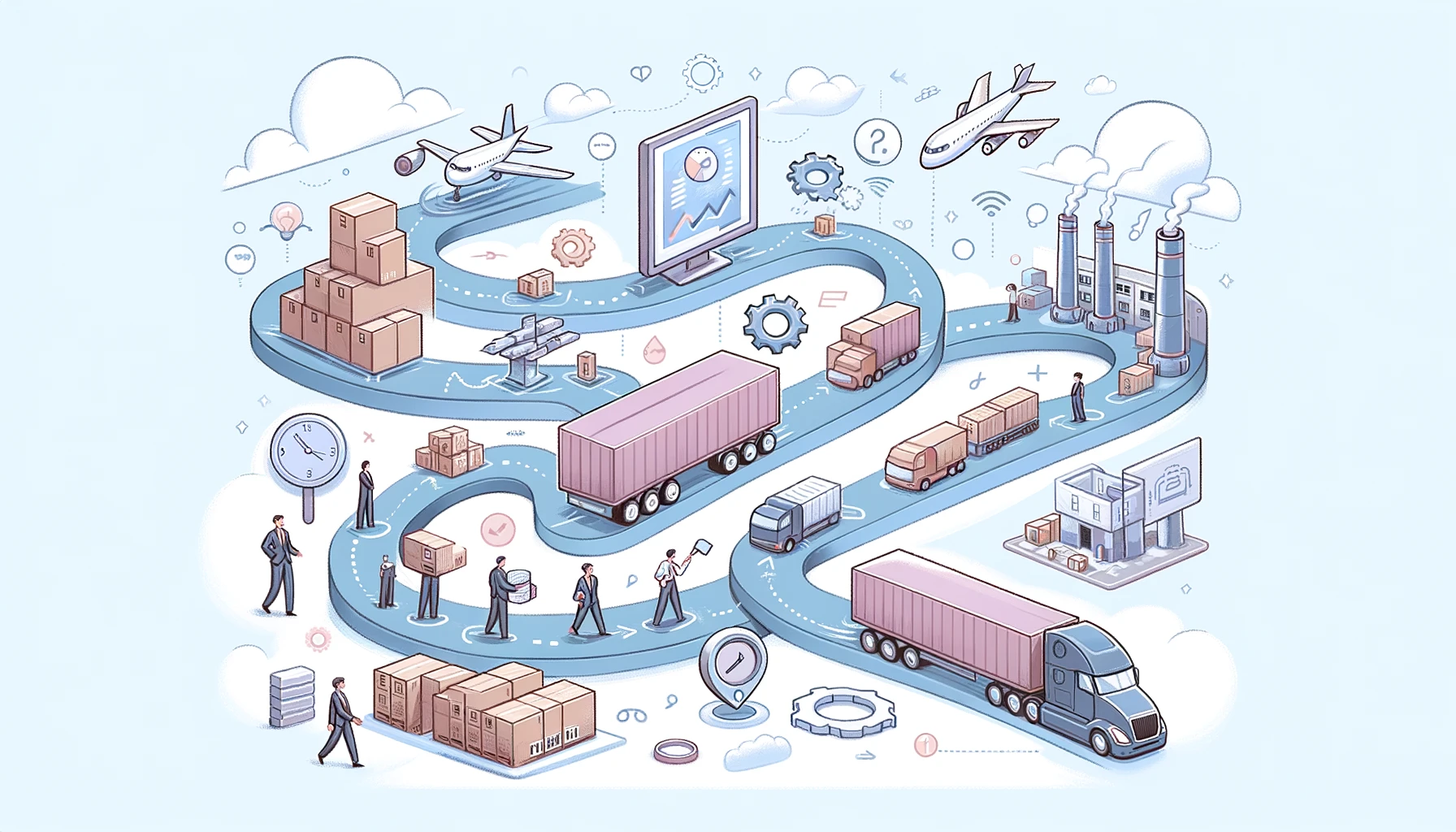Supply Chain Optimization Strategies for Efficiency

Explore the latest strategies in supply chain optimization to streamline operations and enhance business efficiency.
Unlocking the Potential of Supply Chain Optimization
Embarking on the journey of supply chain optimization can yield significant efficiency gains. By implementing strategic enhancements, businesses can streamline processes and reduce operational costs, leading to a more robust bottom line. Let’s delve into how to tap into this potential.
Firstly, it’s crucial to conduct a comprehensive analysis of your existing supply chain. Identify bottlenecks and areas that require improvement. This may involve adopting advanced forecasting techniques to better predict demand and adjust inventory levels accordingly.
Incorporating automation and technology is another pivotal step. Tools such as AI and machine learning can forecast trends and automate routine tasks, cutting down on manual errors and saving valuable time.
To further refine your supply chain, consider:
- Lean inventory management: Keep stock levels optimized to avoid excess while meeting demand.
- Supplier collaboration: Work closely with suppliers to ensure timely deliveries and quality control.
- Transportation management: Optimize delivery routes and consolidate shipments to save on fuel and time.
Remember, every change you implement should aim to enhance agility and responsiveness within your supply network.

By focusing on these areas, you’ll be well on your way to unlocking the full potential of your supply chain, ensuring it becomes a source of competitive advantage.
The Role of Technology in Supply Chain Management
Harnessing the power of technology is a game-changer in supply chain management. In today’s fast-paced market, leveraging tech tools not only enhances operational efficiency but also provides a competitive edge.
Digital transformation within the supply chain involves integrating systems like ERP and cloud computing. These platforms facilitate real-time data sharing and collaboration across the entire network, ensuring that all stakeholders are on the same page.
Moreover, IoT devices track shipments and inventory with precision, leading to improved asset utilization and customer satisfaction. The data collected through these devices drives analytics, helping businesses make informed decisions.
Key technological advancements include:
- Real-time tracking for transparency
- Predictive analytics for demand forecasting
- Automated inventory management systems
Embracing technology in your supply chain strategy means staying ahead of trends and adapting quickly to market changes.

Investing in these technological solutions not only streamlines operations but also paves the way for innovation and growth in the supply chain domain.
Boosting Efficiency with Lean Inventory Techniques
Streamlining inventory is essential for operational excellence. Adopting lean inventory techniques can significantly reduce waste and enhance productivity. These methods ensure you have just the right amount of stock to meet demand without overburdening your storage facilities.
Key strategies include:
- Just-in-Time (JIT) delivery: Aligns production schedules with demand to minimize inventory levels.
- ABC analysis: Categorizes inventory based on importance to prioritize management efforts.
- Cycle counting: Regularly verifies inventory accuracy, promoting better stock control.
By implementing these tactics, companies can enjoy a more flexible and responsive supply chain. This approach not only cuts costs but also boosts customer satisfaction with timely deliveries.

Transitioning to a lean inventory model is a smart move for businesses looking to stay competitive and agile in today’s dynamic market. It’s not just about saving space—it’s about smart resource management for better business health.
Case Study: Success Stories in Supply Chain Optimization
In the realm of supply chain excellence, learning from successful case studies can provide actionable insights. Numerous companies have reaped the benefits of strategic supply chain improvements, witnessing substantial cost reductions and enhanced customer satisfaction.
One such example involved a business overhauling its logistics network, leading to a 20% decrease in transportation costs. By optimizing delivery routes and consolidating shipments, they achieved greater efficiency and a smaller carbon footprint.
Another case highlighted the power of synchronized supply chains, where a company’s integration of suppliers and real-time data analytics resulted in a 15% increase in on-time deliveries. This synchronization not only improved reliability but also fortified partnerships across the supply network.
These stories underscore the impact of:
- Strategic planning and analysis
- Leveraging technology for real-time insights
- Building cohesive relationships with suppliers

Adopting these optimization strategies can transform a supply chain into a streamlined, cost-effective operation that drives business success and customer loyalty.
Getting Started with Supply Chain Optimization
Embarking on supply chain optimization requires a strategic approach. Begin by assessing your current operations to pinpoint inefficiencies. This foundation is vital for setting clear objectives and measurable goals. Start small; focus on one area that can yield quick wins to build momentum and demonstrate the value of optimization efforts.
Consider these steps to jumpstart your optimization process:
- Data Analysis: Harness data to understand your supply chain dynamics.
- Process Mapping: Visualize workflows to identify improvement opportunities.
- Technology Investment: Select tools that align with your business goals.
Engage your team, foster a culture of continuous improvement, and keep scalability in mind. By taking these initial steps, you lay the groundwork for a more efficient, agile supply chain that can adapt to market demands and drive growth.

Optimization is an ongoing journey, but with the right strategy, your supply chain will become a cornerstone of your business success.
FAQs
What is Supply Chain Optimization and Why is it Important?
Supply Chain Optimization refers to the process of enhancing the efficiency and effectiveness of the supply chain processes by improving the operational, tactical, and strategic aspects. It involves analyzing and streamlining supply chain operations to reduce costs, improve speed, increase service levels, and ensure sustainable practices. Its importance lies in its ability to enable companies to meet consumer demand more effectively, manage resources more efficiently, and adapt to market changes swiftly.
How Does Technology Play a Role in Supply Chain Optimization?
Technology is a key enabler in supply chain optimization, offering tools and platforms for better visibility, forecasting, automation, and coordination across the supply chain. Advanced technologies like IoT (Internet of Things), AI (Artificial Intelligence), and blockchain enhance real-time data collection, analytics, and secure information sharing. These technologies help in improving demand forecasting, inventory management, and transportation logistics, leading to more efficient and responsive supply chains.
What are the Key Components of an Optimized Supply Chain?
An optimized supply chain consists of several key components including efficient inventory management, accurate demand forecasting, streamlined logistics and transportation, effective supplier and partner collaboration, and a resilient strategy that can adapt to disruptions. Each component plays a crucial role in ensuring that the right products are delivered to the right place, at the right time, and in the most cost-effective manner.
Can Supply Chain Optimization Lead to Sustainability?
Yes, supply chain optimization can significantly contribute to sustainability efforts. By improving efficiency and reducing waste through better inventory management and transportation strategies, companies can lower their carbon footprint. Additionally, optimizing the supply chain often involves ethical sourcing and considering the environmental impact of supply chain practices, which promotes sustainability.
What are the Challenges in Supply Chain Optimization?
Supply chain optimization faces several challenges, including dealing with the complexity of global supply chains, managing risks and disruptions (such as natural disasters or pandemics), maintaining data security and privacy, and integrating new technologies seamlessly. Additionally, aligning the interests of all stakeholders and adapting to constantly changing market demands are significant hurdles that require continuous attention and strategic planning.





